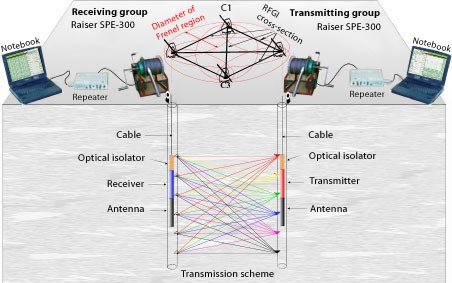Survey Technology
Our technologies help to solve the most complex problems of underground space study
In the past 10 years there was the rapid development of wave methods in exploration and engineering geophysics. First of all, these are subsurface radar probing and crosshole radio-frequency survey that complemented traditional seismic methods. Being different in frequency range, technical arrangement of transmitters and receivers, depth of penetration and resolution capability, the new method modifications on the whole are based on the unified physical-mathematical tool and effectively work under interconnecting.
Modern methods of engineering geophysics, instrumental and equipment and technological solutions, methods of digital data processing are fairly referred to high-end technologies and allow to solve complex problems connected with underground space study (directly under the existing objects) and crosshole surveys that earlier appeared as insoluble.
The general approach is illustrated with the technology of radio-frequency survey for three-dimensional (3D-electric) mapping of crosshole space with the RFGI 2-f-2000 equipment.
Radio-frequency geointroscopy of crosshole space (RFGI) is the latest technology of surveying internal structure of geological environment into the space between the wells. The application of electromagnetic field in radio-frequency range and electric contrast of profile rocks, special techniques of measurement and data processing, tomographic or wave recovery methods allows to detect and localize geological heterogeneities of relatively small size and thickness.
The comprehensive engineering-geophysical and engineering-geological survey
allows to evolve the most weakened zones and segments of changed rocks in the
building (structure) foundation which require reinforcement with the
"Geocomposite" and "Jet-grouting" methods. The technologies of reanimation,
reinforcement of rocks and soils under the projects are referred to in the
section "Monitoring" (case studies).

Method Advantages:
Radio-frequency geointroscopy of crosshole space (RFGI) is the effective method of studying rocks and soils at the foundation of buildings under construction and earlier constructed objects. This is the method that helps "visualize" internal structure of geological environment in the underground space between exploratory holes and can be used both at open building sites and directly under the structures. If there are only two exploratory holes, the survey of the space is conducted along the line connecting these holes. If there are three holes or more and they are located in the area extent, it is possible to study the whole volume of rocks falling into the circuit under consideration (the space between the holes).
RFGI helps to detect and localize in the area under study:
-
geological heterogeneities,
-
karst cavities,
-
sectors of rock heave,
-
water-encroached zones,
-
zones of edge water discharge and sectors of water inflow,
-
to detect migration direction and position of talik zones front in permafrost rocks,
-
to solve a wide range of applied problems during building and reconstruction at the urbanized territories.
The acquired data promote making of valid and maximum effective engineering decisions for design and realization of unique construction and damage control works.
This technology proved its efficiency in solving
non-standard problems at different construction projects in Moscow, during
erection of bridges, metro tunnels, survey of combined building project
foundations, dams and production sectors in the zone of permafrost rocks
development in Yakutia.


